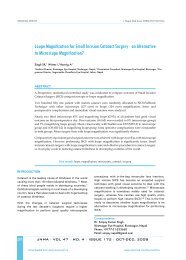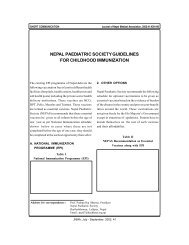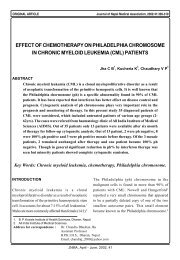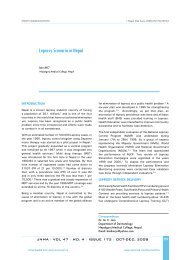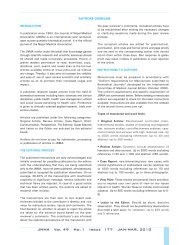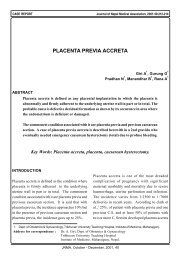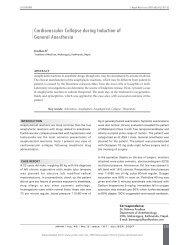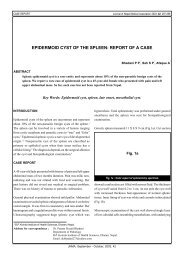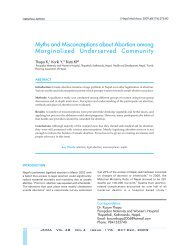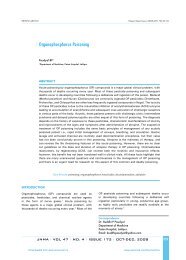incidence of caesarean wound infection in patan hospital, nepal
incidence of caesarean wound infection in patan hospital, nepal
incidence of caesarean wound infection in patan hospital, nepal
You also want an ePaper? Increase the reach of your titles
YUMPU automatically turns print PDFs into web optimized ePapers that Google loves.
281 Pandit et al. Incidence <strong>of</strong> Cesarean Wound Infection <strong>in</strong> Patan Hospital, Nepal<br />
pus and may require secondary procedure. 8<br />
M<strong>in</strong>or <strong>wound</strong> <strong><strong>in</strong>fection</strong>: A <strong>wound</strong> <strong><strong>in</strong>fection</strong> that discharges<br />
pus but doesn't show any systemic response, discomfort or affect<br />
<strong>hospital</strong> stay. 8<br />
In Patan Hospital, patients are discharged on fourth postoperative<br />
day and first post-operative day is counted the day<br />
follow<strong>in</strong>g surgery irrespective <strong>of</strong> time <strong>of</strong> surgery. The data were<br />
collected dur<strong>in</strong>g the morn<strong>in</strong>g rounds from those patients who<br />
developed <strong>wound</strong> <strong><strong>in</strong>fection</strong> dur<strong>in</strong>g <strong>hospital</strong> stay. The patients<br />
who developed <strong>wound</strong> <strong><strong>in</strong>fection</strong> follow<strong>in</strong>g discharge from the<br />
<strong>hospital</strong> were picked up dur<strong>in</strong>g follow up. Although the patients<br />
are advised to come for follow up after one week to Patan<br />
Hospital out patient department, we might have missed few<br />
cases who, didn't report to OPD and went to other private<br />
practitioners.<br />
Number <strong>of</strong> per vag<strong>in</strong>al exam<strong>in</strong>ation: In 14 cases, p v<br />
exam<strong>in</strong>ation was done less 2 times. But these cases were<br />
either associated with premature rupture <strong>of</strong> membrane or<br />
placenta previa where vag<strong>in</strong>al exam<strong>in</strong>ations are restricted<br />
or even contra-<strong>in</strong>dicated. In 12 cases, p v exam<strong>in</strong>ation was<br />
done 2-5 times and <strong>in</strong> four case p v exam<strong>in</strong>ation was done<br />
more than 5 times.<br />
Fig. 2 : Per Vag<strong>in</strong>al Exam<strong>in</strong>ation<br />
We estimated the <strong><strong>in</strong>cidence</strong> and outcome <strong>of</strong> post-operative<br />
<strong>caesarean</strong> section <strong>in</strong> relation to type <strong>of</strong> <strong><strong>in</strong>fection</strong>, type <strong>of</strong><br />
management, duration <strong>of</strong> prolonged <strong>hospital</strong> stay. We also<br />
looked <strong>in</strong>to the <strong><strong>in</strong>cidence</strong> <strong>of</strong> <strong>wound</strong> <strong><strong>in</strong>fection</strong> with age,<br />
Premature rupture <strong>of</strong> membrane (PROM), number <strong>of</strong> vag<strong>in</strong>al<br />
exam<strong>in</strong>ation, color <strong>of</strong> liquor, <strong>in</strong>dication <strong>of</strong> surgery and<br />
experience <strong>of</strong> the surgeons.<br />
RESULTS<br />
Incidence: There were total <strong>of</strong> 1086 <strong>caesarean</strong> section dur<strong>in</strong>g<br />
study period. Out <strong>of</strong> which 30 patients developed either major<br />
or m<strong>in</strong>or <strong>wound</strong> <strong><strong>in</strong>fection</strong> giv<strong>in</strong>g an <strong><strong>in</strong>cidence</strong> <strong>of</strong> 2.76 %.<br />
PROM: Out <strong>of</strong> 30 cases, 10 (33.33%) had premature rupture<br />
<strong>of</strong> membrane. 7 cases had rupture <strong>of</strong> membrane more than 24<br />
hours. 2 cases had more than 6 hours. In 1 case it was only 3<br />
hours duration. Out 7 who had rupture <strong>of</strong> membrane more<br />
than 24 hours, 4 developed major and 3 developed m<strong>in</strong>or<br />
<strong>wound</strong> <strong><strong>in</strong>fection</strong>s.<br />
LIQUOR COLOR: There were 18 cases with clear, 9 cases<br />
with moderate, 2 cases with light and 1 case with thick sta<strong>in</strong><strong>in</strong>g<br />
<strong>of</strong> liquor. Out <strong>of</strong> 18 cases with clear liquor, 6 cases had either<br />
premature rupture <strong>of</strong> membrane more than 24 hours or more<br />
than 3 number <strong>of</strong> p v exam<strong>in</strong>ation.<br />
Type <strong>of</strong> <strong>wound</strong> <strong><strong>in</strong>fection</strong>: There were 13 (43.33%) major and<br />
17 (56.66%) m<strong>in</strong>or <strong>wound</strong> <strong><strong>in</strong>fection</strong>s.<br />
Type <strong>of</strong> Management: 18 cases were managed conservatively<br />
while 12 required resutur<strong>in</strong>g.<br />
Fig. 3 : Duration <strong>of</strong> Hospital Stay<br />
Fig. 1 : Premature rupture <strong>of</strong><br />
membrane<br />
8<br />
7<br />
6<br />
5<br />
4<br />
3<br />
2<br />
1<br />
0<br />
Major<br />
M<strong>in</strong>or<br />
> 24 hours<br />
12-24 hours<br />
< 12 hours<br />
JNMA, September - October, 2003, 42



